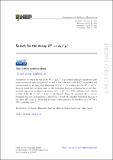Search for the decay B0 → ϕμ+μ−
Author(s)
Aaij, R.; Abdelmotteleb, A. S. W.; Abellán Beteta, C.; Abudinén, F.; Ackernley, T.; Adeva, B.; Adinolfi, M.; Afsharnia, H.; Agapopoulou, C.; Aidala, C. A.; Aiola, S.; Ajaltouni, Z.; Akar, S.; Albrecht, J.; Alessio, F.; Alexander, M.; ... Show more Show less
Download13130_2022_Article_18355.pdf (589.3Kb)
Publisher with Creative Commons License
Publisher with Creative Commons License
Creative Commons Attribution
Terms of use
Metadata
Show full item recordAbstract
Abstract
A search for the decay B0 → ϕμ+μ− is performed using proton-proton collisions at centre-of-mass energies of 7, 8, and 13 TeV collected by the LHCb experiment and corresponding to an integrated luminosity of 9 fb−1. No evidence for the B0 → ϕμ+μ− decay is found and an upper limit on the branching fraction, excluding the ϕ and charmonium regions in the dimuon spectrum, of 4.4 × 10−3 at a 90% credibility level, relative to that of the
B
s
0
$$ {B}_s^0 $$
→ ϕμ+μ− decay, is established. Using the measured
B
s
0
$$ {B}_s^0 $$
→ ϕμ+μ− branching fraction and assuming a phase-space model, the absolute branching fraction of the decay B0 → ϕμ+μ− in the full q2 range is determined to be less than 3.2 × 10−9 at a 90% credibility level.
Date issued
2022-05-11Department
Massachusetts Institute of Technology. Department of PhysicsPublisher
Springer Berlin Heidelberg
Citation
Journal of High Energy Physics. 2022 May 11;2022(5):67
Version: Final published version